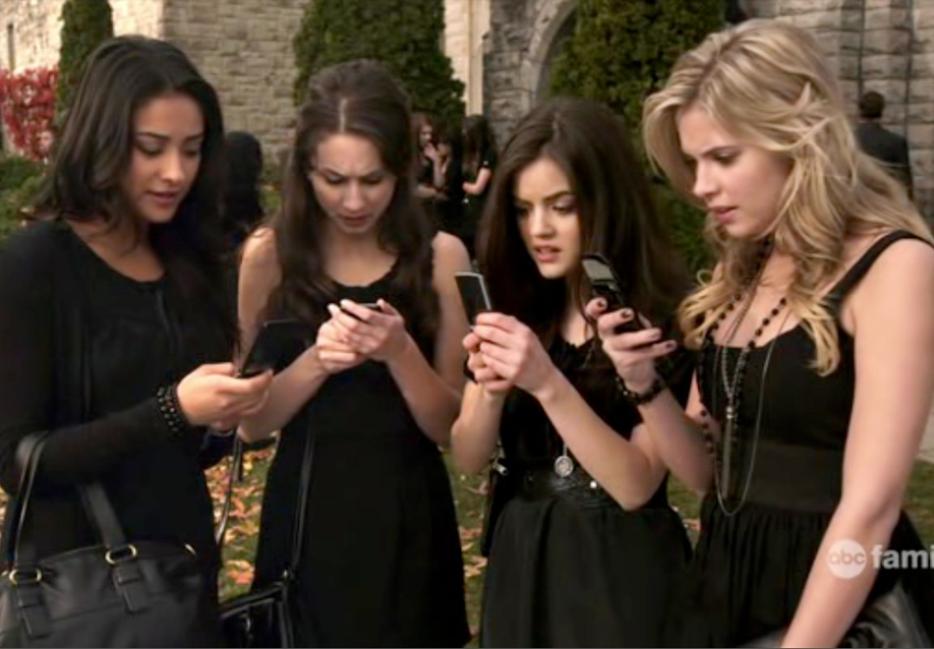A hand emerging from a pile of loosely packed dirt typically hails the beginning of a zombie movie, not the end of a season of teen melodrama. But by the time the dead were (maybe!) rising in the third-season finale of ABC Family’s Pretty Little Liars, it felt less like a shock than a standard scene transition. The twists in this show can come so furious—and be so ridiculous—that a dragon could flambé the main foursome and my primary reaction would be to wonder how long we’ll have to wait (one whole episode? Less?) to find out they’re still alive.
That’s slightly unfair, actually: one of the sheer joys of Pretty Little Liars is how good it is at setting up its twists, at making each one such a visceral thrill that, even if the fact of it were obvious from the opening credits, the details and subsequent pay-off are enough to inspire in you (well, me) incredibly dated bitchy proclamations (“Damn gurllll!”, “Oh no she dinnit!”, etc.). Most of the shows that draw wide cultural attention these days—Pretty Little Liars is not only the network’s most popular show ever, it was the first-ever show to rack up one million tweets while it was airing—have taken some kind of lessons from the plotting of soap operas; Pretty Little Liars has injected the DNA and mutated it into a more perfect form, taking it further even than its teenage melodrama predecessors.
Mostly, that comes from the show’s utterly discombobulating tone. It follows four young girls—nearly all of them look at least 25, but whatever—struggling to get through the end of high school, doubly burdened by the fact that one of their best friends has died under mysterious circumstances. To make matters worse, someone begins using the secrets they thought only that friend knew against them, in what first was a kind of virulent mean-girl cattiness but has evolved into what basically amounts to vicious, extended psychological torture. Solving the mystery of who’s behind it has taken a slight, but not overwhelming, precedence over swimming drills and SATs.
In practice, then, it is both teen melodrama and slasher flick, and it balances these competing impulses by blending them and diving into the slurry from 45 feet above. One of the finest examples of this comes in the second season finale, an extended Psycho homage: literally right after its nod to the shower scene—which mercifully stopped short of actually hacking someone up, but was otherwise pretty much shot for shot, tension included—two of our characters sit on their motel bed and wonder, earnestly, if they can get dates for the masquerade ball that night. The show isn’t always that perfectly bifurcated, but cutting from a character wandering down a dark alley alone to a character wondering what that boy is really thinking happens about three times an episode.
This is a feature, not a bug. The more implausible aspects of the horror are sanded down some—she’s going into that seemingly abandoned warehouse because she has to talk to Toby—and are given extra shock because they can come from nowhere. More importantly, though, the horror and the melodrama combine to capture the real-time emotional experience of teenage life like few things on television.
Freaks and Geeks this is not, quite obviously, but there’s a substantial gulf between looking back on something after 20 years and looking back after 20 minutes. Bittersweet melancholy is the more adult emotion, but there is a ridiculous, live-wire rawness to the teenage experience that’s pretty easily forgotten (or mocked) when the exposed nerve finally dulls a little. Everything feels like a life-or-death experience, a twist that couldn’t have been predicted, an earth-shattering revelation. All of that is literally true in Pretty Little Liars, but it’s subjectively true in almost every first break-up or friend betrayal or failing grade, too.
Though it throws in the horror wrinkle—which I would argue is the perfect way to raise the stakes, since horror is pretty much gory melodrama, anyway—Pretty Little Liars is only the latest in a string of shows to lean on this model, beginning with Beverly Hills 90210 and tracking through The OC and basically everything on The CW, including Gossip Girl, from which Pretty Little Liars took the teen crown. That the chain has basically remained unbroken from when it was first fastened is indicative of its enduring strength, though: these tactics don’t just suddenly become less perfectly suited to their intended audience. Where adult melodrama has to get brainy or stay in the ghetto of attention, however, the teen version just needs to be the most clever incarnation necessary to capture the zeitgeist.
It remains to be seen how long Pretty Little Liars can be that show: its creators have already started promising answers and working on spin-offs, both of which should start sapping the vitality of a series that needs as much ridiculous drama in as few scenes as possible to work properly. But even if the season four finale doesn’t start trending, something else will be there to take its place soon enough, pushing its well-manicured hand out of the dirt, waiting to be grasped.






